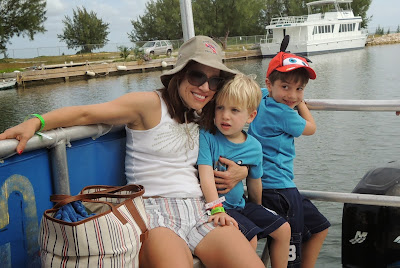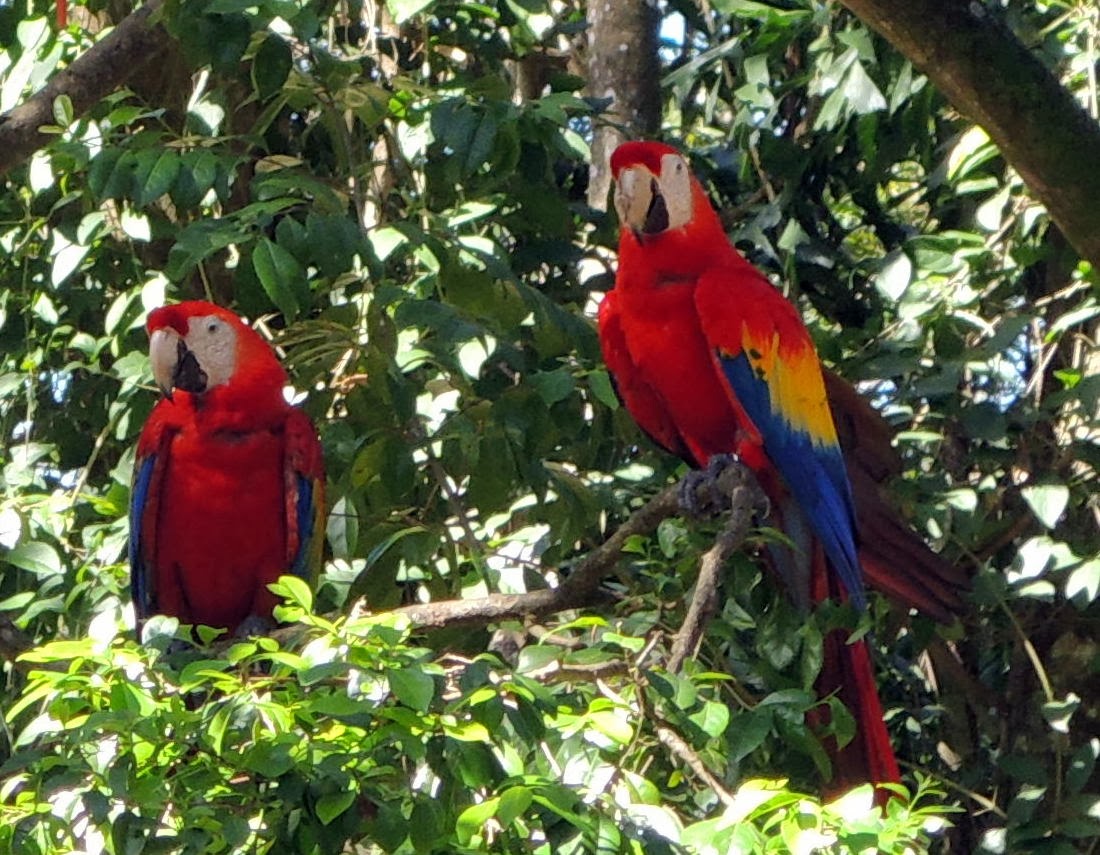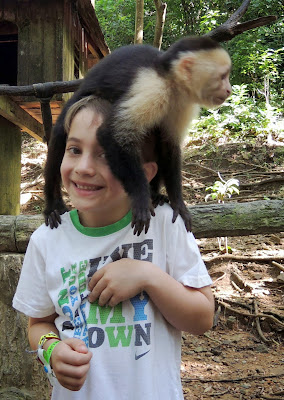 |
| Map on a towel for sale |
We were going on a tour to see a turtle hatchery and to go out to a sand bar and interact with sting rays.
Our tour guide had a very heavy Jamacan accent and was very hard to understand. He also pointed out everything, so we got names of places (when I could understand) but not much in details. His daughter Brea was with him for the day. She had turned 7 the day before. The area is very tourist-driven and is a tax-exempt area.. Everything is imported except for the natural fruit growing there. Gasoline is over $7 a gallon. Most local people need to work 2 or 3 jobs to survive. There are MANY banks and international insurance companies on the island. Since the country is controlled by the British, cars are driven on the left side of the street, and drivers sit in the front on the right.
Timna got Jonah a jaw breaker as we were waiting for our tour to begin. He sucked on it for a long time.
Our tour guide had a very heavy Jamacan accent and was very hard to understand. He also pointed out everything, so we got names of places (when I could understand) but not much in details. His daughter Brea was with him for the day. She had turned 7 the day before. The area is very tourist-driven and is a tax-exempt area.. Everything is imported except for the natural fruit growing there. Gasoline is over $7 a gallon. Most local people need to work 2 or 3 jobs to survive. There are MANY banks and international insurance companies on the island. Since the country is controlled by the British, cars are driven on the left side of the street, and drivers sit in the front on the right.
Timna got Jonah a jaw breaker as we were waiting for our tour to begin. He sucked on it for a long time.
Our first stop was the tiny town of”Hell” and saw a pre-historic
rock formation. There is a post office
where people can send cards from “Hell.”
We also stopped someplace to taste/ buy rum flavored cake.
 |
| Opening coconuts next to Hell gift shot |
We also stopped someplace to taste/ buy rum flavored cake.
Then we went to a turtle education area called the Cayman Turtle Farm and saw some really
big turtles. We also got to hold smaller
ones. That was fun.
8000 sea turtles ranging from hatchlings to 700 pounds but unfortunately we didn't have a guide there and were not pointed in the direction of the education center so we grabbed a quick bite to eat and lost out on a good opportunity. I was disappointed. Here is the website for the place we visited:
http://www.turtle.ky/
The Cayman Islands is one of the rare places where turtles are raised for food. Also 4 families have hereditarily been allowed to fish for turtles, eat and sell them.
 |
| A Coconut palm at the turtle farm |
 |
| large turtle looking at us |
 |
| Turtle traffic jam |
8000 sea turtles ranging from hatchlings to 700 pounds but unfortunately we didn't have a guide there and were not pointed in the direction of the education center so we grabbed a quick bite to eat and lost out on a good opportunity. I was disappointed. Here is the website for the place we visited:
http://www.turtle.ky/
 |
| A little more hesitant than the rest of us |
The Cayman Islands is one of the rare places where turtles are raised for food. Also 4 families have hereditarily been allowed to fish for turtles, eat and sell them.
From there we drove a bit and parked the car to get on a
boat and go 5 miles out from the beat to a special Stingray City sand bar
called where hundreds of female stingrays make their home.
David was our main guide on the ride. He gave us background information on sting rays and how they have made this sandbar their home. They can get plenty of food here--small fish--and are protected from the sharks that prey on them in the open ocean. He also was the photographer.
Unless one had a water proof camera, it was really too difficult to take pictures, so he did and made his living that way. He was a character--a member of one of the four families who can hunt turtles for food. He also said that part of his family originally came from Ethiopian and he has Jewish background from them. I think he was Scottish on his father's side.
We parked on part of the sandbar. We had to climb down a small ladder to get into the water. It was colder than I had expected...probably about 80 degrees or so, maybe a bit more. I got in to get started, then came back to take a few photos.
The people who work with tourists have names for many of the sting rays. “Betsy 2” came up to our group and we got to hold her. She was about 20 years old or so. The males are much smaller than the females. Zekey had on water wings but Jonah could stand up most of the time.
We hugged and played in the water awaiting our turns.
Jonah preferred the turtles to the
stingrays--saying he was scared of the rays, but he was really a good sport and very adventuresome. Zekey was more subdued. I do think the boys were fascinated by them.
The water was filled with waves, going from above waist depth to shoulder depth for me. Sometimes Jonah could stand, but often he could not. We each got to hold the sting ray,
kiss it (for good luck) (except for Zekey)
and have it give us a "back massage."
I was the only one that fed it. Feeders held pieces of squid in a fist with the thumb down. We put our fist under the sting ray by its mount, and it suctioned it into its mouth, a unique feeling....gentle but strong!
We ended up getting a disk of all the photos David took plus some extra photos he has taken of rays and sea life. It was $50 but nice to have the memories. There were other visits with sting rays on others stops on this cruise, but I think this was the only one in relatively shallow water in an open area for the rays and without a minimum age requirement.
Here are some of the stock pictures of the sting rays and the fish underwater in the area:
The End :)
David was our main guide on the ride. He gave us background information on sting rays and how they have made this sandbar their home. They can get plenty of food here--small fish--and are protected from the sharks that prey on them in the open ocean. He also was the photographer.
Unless one had a water proof camera, it was really too difficult to take pictures, so he did and made his living that way. He was a character--a member of one of the four families who can hunt turtles for food. He also said that part of his family originally came from Ethiopian and he has Jewish background from them. I think he was Scottish on his father's side.
We parked on part of the sandbar. We had to climb down a small ladder to get into the water. It was colder than I had expected...probably about 80 degrees or so, maybe a bit more. I got in to get started, then came back to take a few photos.
 |
| a few other tourist boats around us....not a whole lot |
 |
| Timna and boys in the lower right....shallow water with no waves at that moment |
 |
| Crew member from Cuba showed us how to hold the sting ray underneath |
The people who work with tourists have names for many of the sting rays. “Betsy 2” came up to our group and we got to hold her. She was about 20 years old or so. The males are much smaller than the females. Zekey had on water wings but Jonah could stand up most of the time.
We hugged and played in the water awaiting our turns.
 |
| Jonah swimming |
The water was filled with waves, going from above waist depth to shoulder depth for me. Sometimes Jonah could stand, but often he could not. We each got to hold the sting ray,
 |
| He likes it! |
and have it give us a "back massage."
 |
| SR approaching Timna's back |
 |
| It was fun for Z...but a bit heavy for Savta |
We ended up getting a disk of all the photos David took plus some extra photos he has taken of rays and sea life. It was $50 but nice to have the memories. There were other visits with sting rays on others stops on this cruise, but I think this was the only one in relatively shallow water in an open area for the rays and without a minimum age requirement.
Here are some of the stock pictures of the sting rays and the fish underwater in the area:
 |
| Coral |
 |
| Fish among coral |
 |
| Coral |































































































